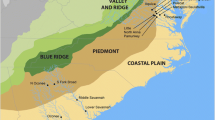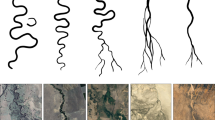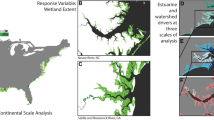Abstract
Efforts to predict responses to climate change and to interpret modern or paleoclimate indicators are influenced by several levels of potential amplifiers, which increase or exaggerate climate impacts, and/or filters, which reduce or mute impacts. With respect to geomorphic responses and indicators, climate forcings are partly mediated by ecological, hydrological, and other processes which may amplify or filter impacts on surface processes and landforms. Then, geomorphic responses themselves may be threshold-dominated or dynamically unstable, producing disproportionately large and long-lived responses to climate changes or disturbances. Or, responses may be dynamically stable, whereby resistance or resilience of geomorphic systems minimizes the effects of changes. Thus a given geomorphic response to climate could represent (at least) two levels of amplification and/or filtering. An example is given for three fluvial systems in Kentucky, U.S.A, the Kentucky, Green, and Big South Fork Rivers. Climate impacts in the early Quaternary were amplified by glacially-driven reorganization of the ancestral Ohio River system to the North, and by dynamical instability in the down-cutting response of rivers incising plateau surfaces. Effects of more recent climate changes, however, have been filtered to varying extents. Using alluvial terraces as an example, the study rivers show distinctly different responses to climate forcings. The lower Green River has extensive, well-developed terraces recording several episodes of aggradation and downcutting, while the Big South Fork River has no alluvial terraces. The Kentucky River is intermediate, with limited preservation of relatively recent terraces. The differences can be explained in terms of differences among the rivers in (1) filtering effects of constraints on fluvial responses imposed by strongly incised, steep-walled bedrock controlled valleys; and (2) amplifier effects of periodic damming of lower river reaches by glaciofluvial outwash.
Similar content being viewed by others
References
Andrews WM Jr (2004) Geologic controls on Plio-Pleistocene drainage evolution of the Kentucky river in Central Kentucky. Ph.D. dissertation, University of Kentucky, Lexington
Anthony DM, Granger DE (2004) A late Tertiary origin for multilevel caves along the western escarpment of the Cumberland Plateau, Tennessee and Kentucky, established by cosmogenic 26Al and 10Be. J Cave Karst Stud 66:46–55
Anthony DM, Granger DE (2007) A new chronology for the age of Appalachian erosional surfaces determined by cosmogenic nuclides in cave sediments. Earth Surf Process Landf 32:874–887
Bartholomew MJ, Mills HH (1991) Old courses of the New River; its late Cenozoic migration and bedrock control inferred from high-level stream gravels, southwestern Virginia. Geol Soc Am Bull 103:73–81
Bridgland D, Westaway R (2008) Climatically controlled river terrace staircases: a worldwide Quaternary phenomenon. Geomorph 98:285–315
Bull WN (1991) Geomorphic responses to climate change. Oxford University Press, New York
Campbell JJN (1980) Present and presettlement forest conditions in the inner bluegrass of Kentucky. Ph.D. dissertation, University of Kentucky, Lexington
Converse FJ, Cox FR Jr (1967) Soil survey of Henderson County, Kentucky. US Department of Agriculture, Washington
Couture NJ, Pollard WH (2007) Modeling geomorphic response to climatic change. Clim Change 85:407–431
Delcourt HR (1979) Late Quaternary vegetation history of the eastern highland rim and adjacent Cumberland Plateau of Tennessee. Ecol Monogr 49:255–280
Delcourt PA, Delcourt HR, Ison CR, Sharp WE, Henderson AG (1999) The story of Cliff Palace Pond, Jackson County, Kentucky. Educational Series No.4. Kentucky Archaeological Survey, Kentucky Heritage Council, Lexington
Dikau R, Schrott L (1999) The temporal stability and activity of landslides in Europe with respect to climate change (TESLEC): main objectives and results. Geomorph 30:1–12
Erkens G, Dambeck R, Volleberg KP, Bouman MTIJ, Bos JAA, Cohen KM, Willinga J, Hoek WZ (2009) Fluvial terrace formation in the northern upper Rhine Graben during the last 20 000 years as a result of allogenic controls and autogenic evolution. Geomorph 103:476–496
Gibbard PL, Boreham S, Cohen KM, Moscariello A (2007) Global chronostratigraphical correlation table for the last 2.7 million years v. 2007b. Boreas 34: unpaginated (poster originally published 2005; modified/updated 2007). Department of Geography, University of Cambridge, Cambridge
Granger DE, Smith AL (2000) Dating buried sediments using radioactive decay and muogenic production of 26Al and 10Be. Nucl Instrum Methods Phys Res B 172:822–826
Granger DE, Kirchner JW, Finkel RC (1997) Quaternary downcutting rate of the New River, Virginia, measured from differential decay of cosmogenic 26Al and 10Be in cave-deposited alluvium. Geology 25:107–110
Granger DE, Fabel D, Palmer AN (2001) Pliocene–Pleistocene incision of the Green River, Kentucky, determined from radioactive decay of cosmogenic 26Al and 10Be in Mammoth Cave sediments. Geol Soc Am Bull 113:825–836
Gray HH (1991) Origin and history of the Teays drainage system. The view from midstream. In: Melhorn WN, Kempton JP (eds) Geology and hydrogeology of the Teays-Mahomet bedrock valley systems: Geological Society of America special paper no. 258. Geological Society of America, New York, pp 43–50
Grime JP, Fridley JD, Askew AP, Thompson K, Hodgson JG, Bennett CR (2008) Long-term resistance to simulated climate change in an infertile grassland. Proc Natl Acad Sci U S A 105:10028–10032
Hancock G, Kirwan M (2007) Summit erosion rates deduced from 10Be: implications for relief production in the central Appalachians. Geology 35:89–92
Holmgren CA, Rosello E, Latorre C, Betancourt JL (2008) Late-Holocene fossil rodent middens from the Arica region of northernmost Chile. J Arid Environ 72:677–686
Houben P (2003) Spatio-temporally variable response of fluvial systems to late Pleistocene climate change: a case study from central Germany. Quat Sci Rev 22:2125–2140
Huggett RJ (1991) Climate, earth processes and earth history. Springer, Berlin
Huggett RJ (1997) Environmental change. The evolving ecosphere. Routledge, London
Jomelli V, Brunstein D, Grancher D, Pech P (2007) Is the response of hill slope debris flows to climate change univocal? A case study in the Massif des Ecrins (French Alps). Clim Change 85:119–137
Kaplan MR, Hein AS, Hubbard A, Lax SM (2009) Can glacial erosion limit the extent of glaciation? Geomorph 103:172–179
Kasse C, Vandenberghe J, Van Huissteden J, Bohncke SJP, Bos JAA (2003) Sensitivity of Weichselian fluvial systems to climate change (Nocten mine, eastern Germany). Quat Sci Rev 22:2141–2156
Keay-Bright J, Boardman J (2009) Evidence from field-based studies of rates of soil erosion on degraded land in the central Karoo, South Africa. Geomorph 103:455–465
Knox JC (1993) Large increases in flood magnitude in response to modest changes in climate. Nature 361:430–432
Knox JC (2000) Sensitivity of modern and Holocene floods to climate change. Quat Sci Rev 19:439–457
Kupfer JA, Cairns DM (1996) The suitability of montane ecotones as indicators of global climatic change. Prog Phys Geogr 20:253–272
Lane SN, Reid SC, Tayefi V, Yu D, Hardy RJ (2008) Reconceptualizing coarse sediment delivery problems in rivers as catchment-scale and diffuse. Geomorph 98:227–249
Leigh DS (2006) Terminal Pleistocene braided to meandering transition in rivers of the southeastern USA. Catena 66:155–160
Leigh DS (2008) Late Quaternary climates and river channels of the Atlantic coastal plain, southeastern USA. Geomorph 101:90–108
Liu Z, Harrison SP, Kutzbach J, Otto-Bleisner B (2004) Global monsoons in the mid-Holocene and oceanic feedback. Clim Dyn 22L:157–182
Martin LL (2006) Effects of forest and grass vegetation on fluviokarst hillslope hydrology, Bowman’s Bend, Kentucky. Ph.D. dissertation, University of Kentucky, Lexington
Mills HH, Kaye JM (2001) Drainage history of the Tennessee River: review and new metamorphic quartz gravel locations. Southeast Geol 40:75–97
Mills HH, Wagner JR (1985) Long-term change in regime of New River indicated by vertical variation in extent and weathering intensity of alluvium. J Geol 93:131–142
Moore DW, Newell WL, Counts RC, Fraser GS, Fishbaugh DA, Brandt TR (2007) Surficial geologic map of the West Franklin Quadrangle, Vanderburgh and Posey Counties, Indiana, and Henderson County, Kentucky. U.S. Geological Survey Scientific Investigations Map 2967, scale 1:24,000
Morey DF, Crothers GM, Stein JK, Fenton JP, Hermann NP (2002) The fluvial and geomorphic context of Indian Knoll, an Archaic shell midden in west-central Kentucky. Geoarch Int J 17:521–553
Nield JM, Baas ACW (2008) The influence of different environmental and climatic conditions on vegetated aeolian dune landscape development and response. Glob Planet Change 64:76–92
Palmer AN (1981) A geological guide to mammoth cave national park. Zephyrus, Teaneck
Phillips JD (2005) Weathering, instability, and landscape evolution. Geomorph 67:255–272
Phillips JD, Lutz JD (2008) Profile convexities in bedrock and alluvial streams. Geomorph 102:554–566
Phillips JD, Walls MD (2004) Flow partitioning and unstable divergence in fluviokarst evolution in central Kentucky. Nonlinear Process Geophys 11:371–381
Phillips JD, Martin LL, Nordberg VG, Andrews WA (2004) Divergent evolution in fluviokarst landscapes of central Kentucky. Earth Surf Process Landf 29:799–819
Ray LL (1974) Geomorphology and Quaternary geology of the glaciated Ohio River valley; a reconnaissance study. U.S. Geological Survey professional paper PP-826, 77 p
Rodbell DT, Forman SL, Pierson J, Lynn WC (1997) Stratigraphy and chronology of Mississippi Valley loess in western Tennessee. Geol Soc Am Bull 109:1134–1148
Rother H, Shulmeister J (2006) Synoptic climate change as a driver of late Quaternary glaciations in the mid-latitudes of the southern hemisphere. Clim Past 2:11–19
Roy M, Clark PU, Barendregt RW, Glasmann JR, Enkin RJ (2004) Glacial stratigraphy and paleomagnetisms of late Cenozoic deposits of the north-central United States. Geol Soc Am Bull 116:30–41
Schumm SA (2005) River variability and complexity. Cambridge, New York
Shen C, Wang W-C, Hao Z, Gong W (2007) Exceptional drought events over eastern China over the last five centuries. Clim Change 85:453–471
Stiff BJ, Hansel AK (2004) Quaternary glaciations in Illinois. In: Ehlers J, Gibbard PL (eds) Quaternary glaciations—extent and chronology. Part II. North America. Amsterdam, Elsevier, pp 71–82
Swadley WC (1971) The preglacial Kentucky River of northern Kentucky. US Geol Surv Prof Pap PP-750D:D127–D131
Sylvia DA, Galloway WE (2006) Morphology and stratigraphy of the late Quaternary lower Brazos valley: implications for paleo-climate, discharge, and sediment delivery. Sed Geol 190:159–175
Szabo BJ, Chanda A (2004) Pleistocene glaciation of Ohio, USA. In: Ehlers J, Gibbard PL (eds) Quaternary glaciations—extent and chronology. Part II. North America. Amsterdam, Elsevier, pp 233–236
Tebbens LA, Veldkamp A, Westerhoff W, Kroonenberg SB (1999) Fluvial incision and channel downcutting as a response to late-glacial and early Holocene climate change: the lower reach of the River Meuse (Maas), The Netherlands. J Quat Sci 14:59–75
Teller JT, Goldthwait RP (1991) The old Kentucky River: a major tributary to the Teays River. In: Melhorn WN, Kempton JP (eds) Geology and hydrogeology of the Teays-Mahomet bedrock valley systems: Geological Society of America special paper no. 258. Geological Society of America, New York, pp 29–41
Thomas MF (2008) Understanding the impacts of late Quaternary climate change in tropical and sub-tropical regions. Geomorph 101:146–158
Vandenberghe J (1995) Timescales, climate and river development. Quat Sci Rev 14:631–638
Vandenberghe J (2002) The relation between climate and river processes, landforms, and deposits during the Quaternary. Quat Int 91:17–23
Vandenberghe J (2003) Climate forcing of fluvial system development: an evolution of ideas. Quat Sci Rev 22:2053–2060
Vandenberghe J (2008) The fluvial cycle at cold–warm–cold transitions in lowland regions: a refinement of theory. Geomorph 98:275–284
Veldkamp A, Tebbens LA (2001) Registration of abrupt climate changes within fluvial systems: insights from numerical modeling experiments. Glob Planet Change 28:129–144
Vis G-J, Kasse C, Vandenberghe J (2008) Late Pleistocene and Holocene palaeogeography of the lower Tagus Valley (Portugal): effects of relative sea level, valley morphology, and sediment supply. Quat Sci Rev 27:1682–1709
Ward DJ, Spotila JA, Hancock GS, Galbraith JM (2005) New constraints in the late Cenozoic incision history of the New River, Virginia. Geomorph 72:54–72
Waters MR, Nordt LC (1995) Late Quaternary floodplain history of the Brazos River in east-central Texas. Quat Res 43:311–319
Watts WA (1980) The late Quaternary vegetation history of the southeastern United States. Ann Rev Ecolog Syst 11:387–409
White WB (2007) Evolution and age relations of karst landscapes. Acta Carsol 36:45–54
Wilkins GR, Delcourt PA, Delcourt HR, Harrison FW, Turner MR (1991) Paleoecology of central Kentucky since the last glacial maximum. Quat Res 36:224–239
Author information
Authors and Affiliations
Corresponding author
Rights and permissions
About this article
Cite this article
Phillips, J.D. Amplifiers, filters and geomorphic responses to climate change in Kentucky rivers. Climatic Change 103, 571–595 (2010). https://doi.org/10.1007/s10584-009-9775-z
Received:
Accepted:
Published:
Issue Date:
DOI: https://doi.org/10.1007/s10584-009-9775-z




